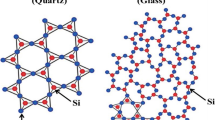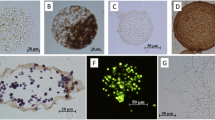Abstract
Sol-gel derived silica has tremendous applications as a biocompatible scaffold for the immobilization of cells. The use of xerogel as a matrix in the blueprint of biosensors is an appealing proposition due to several inimitable characteristics of xerogels, primarily because of their high porous nature, amendable pore size, and exceptionally large internal surface area. Morphological (X-Ray Diffraction and Thermogravimmetric Analysis) and optical (Fourier Transform Infrared and UV-Vis absorption) studies of the silica matrices with entrapped Rhizobial (Rz) structure of the biomaterial has been made. Temporal and concentration dependent studies were conducted for impregnated samples; it showed that the response time for the new biosensor for determining the concentration of Rz is less than 20 min. In this work, first time a novel avenue to create a generic approach for the fabrication of biosensor has been created.
Similar content being viewed by others
References
Zourob M (2008). In Principles of Bacterial Detection: Biosensors, Recognition Receptors and Microsystems Springer, New York, pp. 109–123
Kishen A, John M S, Lim C S, Asundi A (2003). A fiber optic biosensor (FOBS) to monitor mutans streptococci in human saliva. Biosens Bioelectron, 18(11): 1371–1378
Tsai H C, Doong R A, Chiang H C, Chen K T (2003). Sol-gel derived urease-based optical biosensor for the rapid determination of heavy metals. Anal Chim Acta, 48(1): 75–81
Barbe C J, Kong L, Finnie K S, Calleja S, Hanna J V, Drabarek E, Cassidy D T, Blackford M G (2008). Sol-gel matrices for controlled release: from macro to nano using emulsion polymerisation. J Sol-Gel Sci Technol, 46(3): 393–401
Desimone M F, Alvarez G S, Foglia M L, Diaz L E (2009). Development of sol-gel hybrid materials for whole cell immobilization. Recent Pat Biotechnol, 3(1): 55–60
Gupta R, Kumar A (2008). Bioactive materials for biomedical applications using sol-gel technology. Biomed Mater, 3(3): 034005
Shaomin L, Zhi P X, Aimin Y, Haibin S, Lihong L (2007). New biosensors made of specially designed transparent chips with nanooptical tags. Smart Mater Struct, 16(6): 2214–2221
MacDonald C, Morrow R, Weiss A S, Bilek M M M (2008). Covalent attachment of functional protein to polymer surfaces: a novel onestep dry process. J R Soc Interface, 5(23): 663–669
Niki M, Solovieva N, Apperson K, Birch D J S, Voloshinovskii A (2005). Scintillators based on aromatic dye molecules doped in a solgel glass host. Appl Phys Lett, 86(10): 101914–101920
Sharma S, Mohan D, Singh N, Sharma M, Sharma A K (2008a). Spectroscopic and lasing properties in xanthene dyes encapsulated in silica and polymeric matrices. Optik (Stuttg), 121(1): 11–18
Sharma S, Mohan D, Ghoshal S K (2008b). Measurement of nonlinear properties and optical limiting ability of Rhodamine6G doped silica and polymeric samples. Opt Commun, 281(10): 2923–2930
Somasegaran P, Hoben H J (1985). Methods in legume-Rhizobium technology. NIFTAL project and MIRCEN, University of Hawaii, HI
Vincent J M (1970). A manual for the practical study of root-nodule bacteria. IBP Handbook 15, Blackwell, Oxford, pp. 164–171
Rao N S S (1999). Soil Microbiology. Oxford and IBH Publishing Co. Pvt. Ltd. New Delhi, Calcutta, pp. 181–187
Arnon D I, Hoagland D R (1940). Crop production in artificial culture solution and in soil with reference to factors influencing yields and absorption of inorganic nutrient. Soil Sci, 50: 463–469
Huang Y, Siganakis G, Moharam M G, Wu S T (2004). Broadband. Optical limiter based on photo induced anisotropy of bacteriorhodopsin films. Appl Phys Lett, 5(29): 5445–5452
Shah N H, Hafeez F Y, Asad S, Hussain A, Malik K A (1995) Biotechnology for Sustainable Development. (Eds.): K.A. Malik A. N and Khalid A M, NIBGE, Faisalabad, Pakistan, pp. 211–217
Anand R C, Dogra R C (1991). Physiological and biochemiscal characteristics of fast and slow growing Rhizobium sp., from pigeon pea (Cajanus cajan). J Appl Bacteriol, 70(3): 197–204
Author information
Authors and Affiliations
Corresponding authors
Rights and permissions
About this article
Cite this article
Arora, P., Sharma, S., Ghoshal, S.K. et al. A functional approach toward xerogel immobilization for encapsulation biocompatibility of Rhizobium toward biosensor. Front. Biol. 8, 626–631 (2013). https://doi.org/10.1007/s11515-013-1286-7
Received:
Accepted:
Published:
Issue Date:
DOI: https://doi.org/10.1007/s11515-013-1286-7




